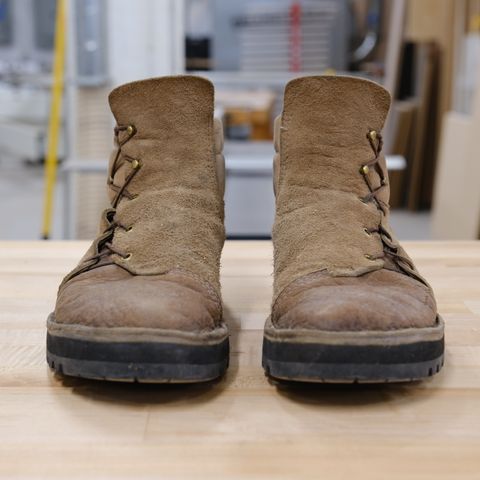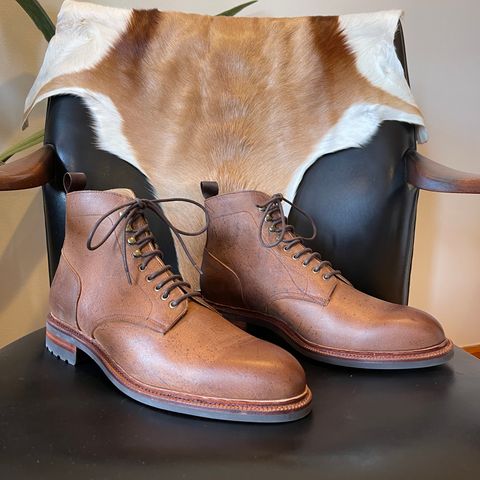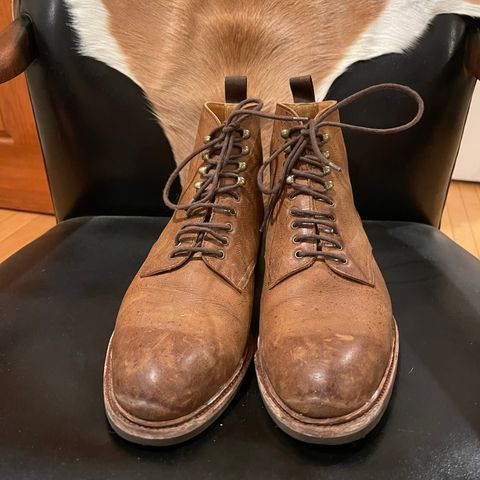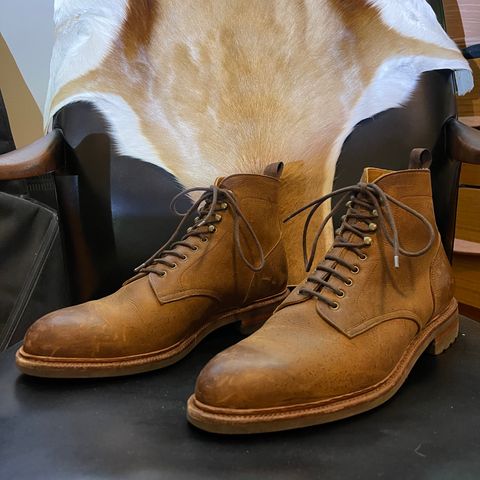About
Autumn Spice is a color variation of C.F. Stead Waxed Kudu leather, produced by the Charles F. Stead & Co tannery in Leeds, United Kingdom. The leather features warm brown tones characteristic of an autumn color palette, combined with the natural grain blemishes and waxed finish distinctive to kudu leather. Sourced from kudu antelope native to Southern Africa, this leather has been used by heritage footwear manufacturers including Meermin Shoes and Oak Street Bootmakers for boots and shoes since its introduction to the product line.
About
Autumn Spice is a color variation of C.F. Stead Waxed Kudu leather, produced by the Charles F. Stead & Co tannery in Leeds, United Kingdom. The leather features warm brown tones characteristic of an autumn color palette, combined with the natural grain blemishes and waxed finish distinctive to kudu leather. Sourced from kudu antelope native to Southern Africa, this leather has been used by heritage footwear manufacturers including Meermin Shoes and Oak Street Bootmakers for boots and shoes since its introduction to the product line.
Manufacturing process
Autumn Spice waxed kudu is produced using C.F. Stead's proprietary Janus tannage method, which was designed to maximize the natural mellowness of the hide. The leather undergoes chrome tanning followed by a full wax impregnation applied to the grain side. This tanning process intentionally highlights the natural grain blemishes, marks, and scratches that result from the kudu's wild environment in the African bush.
The hides are sourced from seasonal licensed culls conducted as part of government-mandated population management programs in southern Africa. Each hide averages 13 to 15 square feet, with individual pieces ranging from 10 to 22 square feet depending on the animal. The leather maintains a thickness of 1.6 to 2.2 millimeters (4.5 to 5.5 ounces), providing a balance between flexibility and durability.
Leather characteristics
The Autumn Spice variation combines the inherent properties of kudu leather with a warm, burnished brown color tone. The leather retains all natural blemishes, scars, and grain variations from the wild antelope, with each hide displaying unique markings. The waxed finish creates a natural sheen that highlights these characteristics while providing protection against moisture.
The leather is thick yet extremely soft, maintaining the inherent suppleness characteristic of kudu hides. The grain side is intended for use in footwear construction, while the reverse side features a soft suede texture. The wax impregnation creates pull-up characteristics, where the leather shows temporary lighter areas when flexed or stretched.
Aging and care
Waxed kudu in the Autumn Spice color develops patina moderately quickly compared to other leather types. The high oil and wax content creates color contrast effects as the leather ages, with natural sheen developing over time. The leather becomes more comfortable with extended wear, conforming to the shape of the foot while maintaining its structural integrity.
To maintain the waxed finish, periodic conditioning prevents the leather from drying out. Recommended care products include Dubbin Wax or Renovateur, applied sparingly to nourish and waterproof the leather. The leather should be cleaned with a dry or slightly damp cloth before applying conditioner, allowing the material to absorb the treatment fully.
Applications in heritage footwear
Meermin Shoes has incorporated Autumn Spice waxed kudu into multiple boot styles across their product line, including service boots, jodhpur boots, and Chelsea boots. Oak Street Bootmakers offered the leather in their Trench Boot model as a limited edition. The leather's combination of durability and unique aesthetic has made it suitable for heritage footwear construction, where the natural character of the material contributes to the visual appeal of the finished product.
Color variations
Autumn Spice (sometimes referenced simply as "Spice") is one of several color options available in C.F. Stead's waxed kudu line. Other colors in the range include Deep Forest, Seaweed, Flint, Bitter Chocolate, Nutmeg, and Stone. The availability of specific colors changes seasonally based on hide availability and tannery production schedules. Lighter colors in the range tend to show more prominent natural marks and scars from the wild animal's life.
References
"Waxed Kudu". Charles F Stead and Co Ltd. Retrieved September 30, 2025.
"C.F. Stead Waxy Kudu Leather". The Tannery Row. Retrieved September 30, 2025.
"Waxy Kudu". Meermin Shoes. Retrieved September 30, 2025.
"116711 - AUTUMN SPICE WAXY KUDU - E (ULTRAFLEX SYSTEM)". Meermin Shoes. Retrieved September 30, 2025.
"African Kudu - C.F. Stead Co.". Mill Hand Made. Retrieved September 30, 2025.























































